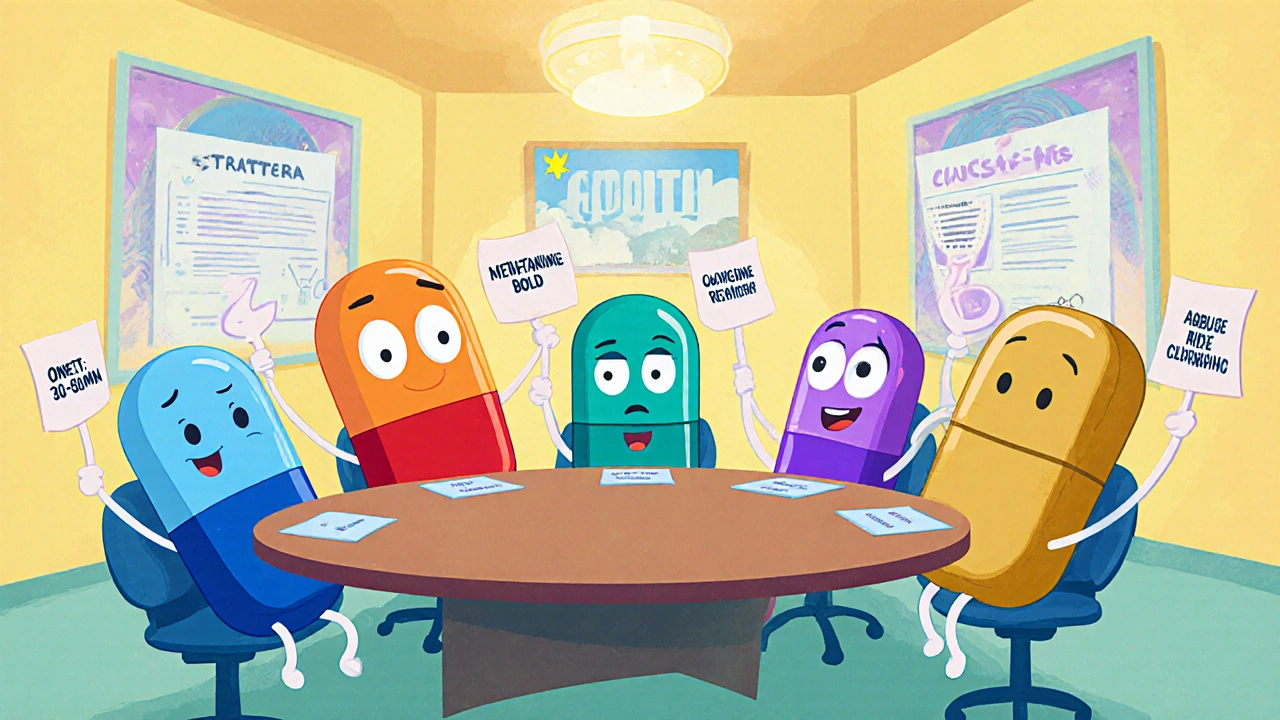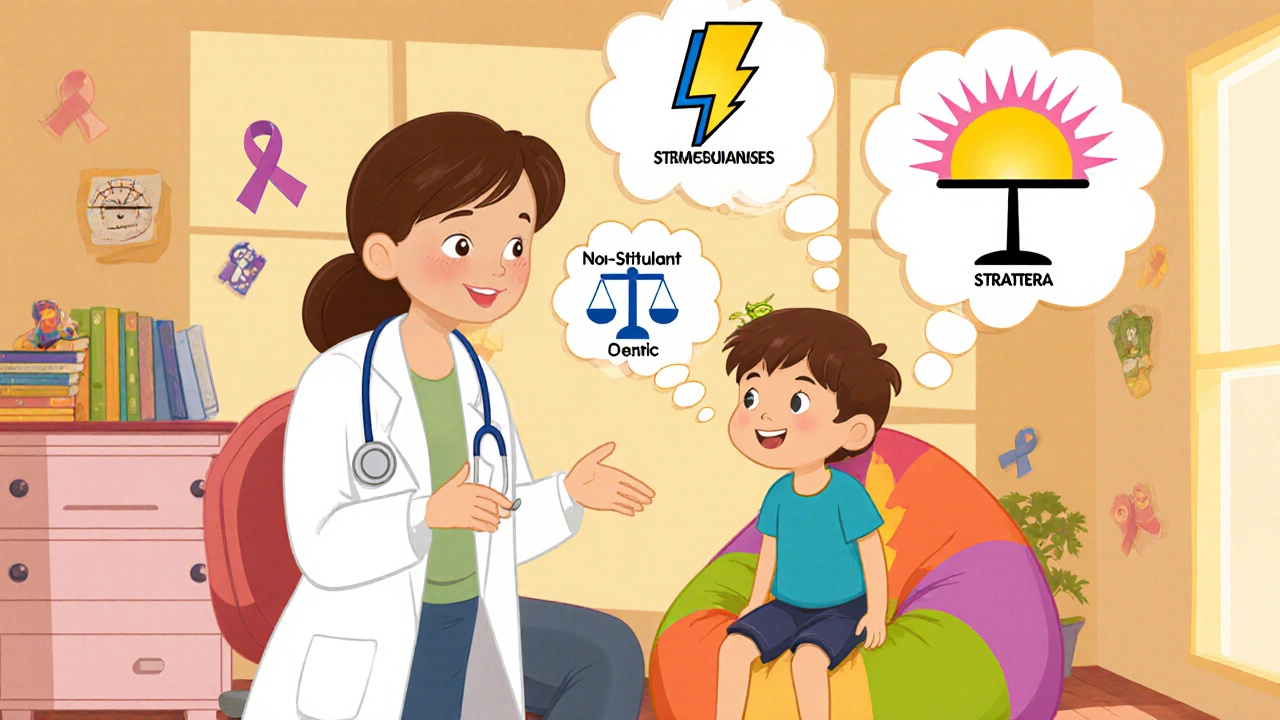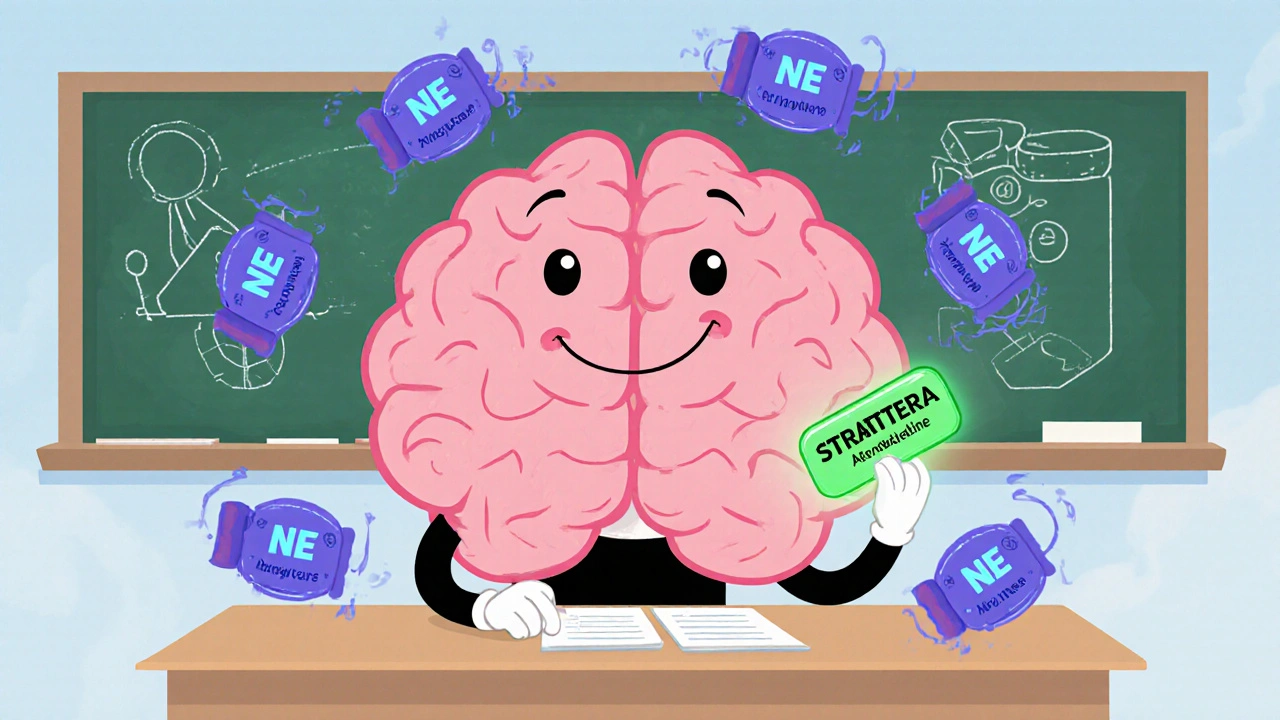ADHD Medication Selector
Select Your Profile
When it comes to treating ADHD, patients and clinicians often wonder if Strattera comparison can help decide whether to stick with Atomoxetine or explore other options. Below is a side‑by‑side look at the most common alternatives, how they differ in effectiveness, safety, and daily life impact.
What is Strattera (Atomoxetine)?
Strattera is a prescription medication whose active ingredient is Atomoxetine. It belongs to the class of selective norepinephrine reuptake inhibitors (NRIs) and works by increasing norepinephrine levels in the brain, which helps improve attention and reduce impulsivity. FDA approved it in 2002 for children, adolescents, and adults with ADHD.
How Atomoxetine Works
Unlike stimulants that flood the brain with dopamine and norepinephrine, Atomoxetine blocks the norepinephrine transporter, leading to a gradual rise in neurotransmitter activity. This mechanism means a steady effect that can take 2-4 weeks to reach full benefit, but it also lowers the risk of abuse because it isn’t a controlled substance.
Key Benefits and Common Side Effects
- Non‑stimulant, so no e‑cigarette‑style “high” or dependence risk.
- Works equally well for patients who don’t respond to stimulants.
- Typical side effects: dry mouth, insomnia, decreased appetite, and occasional stomach upset.
- Rare but serious: increased blood pressure, liver enzyme elevation, and suicidal thoughts in adolescents.

Major Alternatives to Strattera
Below are the most widely prescribed ADHD drugs that clinicians turn to when Atomoxetine isn’t the best fit.
Methylphenidate (Ritalin, Concerta)
Methylphenidate is a stimulant that blocks dopamine and norepinephrine reuptake, delivering a rapid boost in focus. It’s available in immediate‑release (IR), extended‑release (ER), and long‑acting (LA) formulations.
Amphetamine (Adderall, Vyvanse)
Amphetamine‑based meds increase dopamine release and inhibit reuptake. Vyvanse is a pro‑drug that converts to active amphetamine after ingestion, providing a smoother onset.
Guanfacine (Intuniv)
Guanfacine is an alpha‑2A adrenergic agonist that improves prefrontal cortex regulation. It’s often used as an adjunct to stimulants or as a stand‑alone in cases where appetite loss is a concern.
Clonidine (Kapvay)
Clonidine works similarly to guanfacine but is typically prescribed for sleep‑related ADHD symptoms and can also reduce hyperactivity.
Bupropion (Wellbutrin)
Bupropion is an atypical antidepressant that blocks norepinephrine‑dopamine reuptake. Though off‑label for ADHD, it can be useful for patients with co‑existing mood disorders.
Comparison Criteria
When weighing Strattera against its alternatives, clinicians usually look at five core dimensions.
- Efficacy: Measured by symptom‑reduction scores on standardized scales.
- Onset & Duration: How quickly the drug works and how long the effect lasts.
- Side‑Effect Profile: Frequency of insomnia, appetite loss, cardiovascular changes, etc.
- Abuse Potential: Whether the medication is a controlled substance.
- Cost & Insurance Coverage: Out‑of‑pocket expense for patients.
Side‑by‑Side Comparison Table
| Drug | Class | Efficacy (average % symptom reduction) | Onset | Duration | Abuse Risk | Typical Side Effects |
|---|---|---|---|---|---|---|
| Strattera (Atomoxetine) | Norepinephrine Reuptake Inhibitor | ≈55‑65% | 2-4 weeks | 24 hrs (once‑daily) | None (non‑controlled) | Dry mouth, insomnia, appetite loss, ↑BP |
| Methylphenidate (Ritalin/Concerta) | Stimulant | ≈70‑80% | 30‑60 min | 8‑12 hrs (ER/LA) | High (Schedule II) | Insomnia, appetite loss, irritability, ↑HR |
| Amphetamine (Adderall/Vyvanse) | Stimulant | ≈75‑85% | 30‑45 min | 10‑14 hrs (Vyvanse) | High (Schedule II) | Appetite suppression, anxiety, tics |
| Guanfacine (Intuniv) | Alpha‑2A agonist | ≈45‑55% | 1‑2 weeks | 24 hrs (once‑daily) | None (non‑controlled) | Drowsiness, low BP, fatigue |
| Clonidine (Kapvay) | Alpha‑2 agonist | ≈40‑50% | 1‑2 weeks | 12‑24 hrs | None (non‑controlled) | Drowsiness, dry mouth, hypotension |
| Bupropion (Wellbutrin) | Atypical antidepressant | ≈45‑55% (off‑label) | 1‑2 weeks | 12 hrs (twice‑daily) | Low (non‑controlled) | Insomnia, dry mouth, seizure risk at high dose |

Choosing the Right Medication for Different Patient Profiles
ADHD is a neurodevelopmental disorder characterized by inattention, hyperactivity, and impulsivity. Below are typical scenarios and a quick rule‑of‑thumb for drug selection.
- Patients with a history of substance misuse: Non‑stimulants like Strattera or Guanfacine are safest.
- Those needing rapid symptom control (e.g., before exams): Short‑acting methylphenidate or amphetamine provides fast onset.
- Kids with significant appetite or growth concerns: Guanfacine or Clonidine often cause less weight loss than stimulants.
- Adults with co‑occurring depression: Bupropion can address both mood and attention symptoms.
- Patients with high blood pressure or cardiac issues: Avoid stimulants; consider Strattera (monitor BP) or guanfacine (lowers BP).
Practical Tips for Switching or Combining Therapies
- Consult the prescriber before any change - abrupt discontinuation can cause rebound symptoms.
- When moving from a stimulant to Strattera, taper the stimulant over 1‑2 weeks to reduce withdrawal.
- Consider a brief “washout” period of 48‑72 hours for short‑acting stimulants before starting Atomoxetine.
- Monitor blood pressure and heart rate at baseline, then at weeks 2, 4, and 8 after the switch.
- Combine a low‑dose non‑stimulant with behavioral therapy for synergistic benefits.
Frequently Asked Questions
Is Strattera a controlled substance?
No. Atomoxetine is not scheduled by the DEA, so it carries a much lower abuse risk than stimulants.
How long does it take for Strattera to work?
Most patients notice improvement after 2‑4 weeks, although the full therapeutic effect may take up to 8 weeks.
Can I use Strattera with a stimulant?
Yes, some clinicians prescribe a low‑dose stimulant alongside Atomoxetine for patients who need extra focus, but the combination should be closely monitored.
What genetic factor influences Strattera metabolism?
The enzyme CYP2D6 metabolizes Atomoxetine. Poor metabolizers may experience higher blood levels and need dose adjustments.
Is behavioral therapy still needed if I take medication?
Yes. Evidence from the FDA shows that combining medication with behavioral interventions yields the best long‑term outcomes.
Choosing the right ADHD treatment isn’t a one‑size‑fits‑all decision. By comparing efficacy, side‑effects, abuse potential, and cost, you can match the medication profile to a patient’s unique needs. Strattera offers a non‑stimulant path, while alternatives like methylphenidate and amphetamine deliver rapid results at the expense of higher control requirements. Talk with a healthcare professional to weigh these factors and find the optimal plan.


Natalie Morgan
October 20, 2025 AT 17:37Strattera provides a non‑stimulant path for ADHD treatment. It works by raising norepinephrine levels without a rapid dopamine surge. The medication needs two to four weeks to show full benefit. Regular blood‑pressure checks are advised.
Mahesh Upadhyay
October 27, 2025 AT 10:44The stimulant market is a moral hazard that fuels abuse. Strattera stands as a sober, schedule‑free alternative. Its efficacy may lag but it protects patients from dependency. We must prioritize safety over instant relief.
Rajesh Myadam
November 3, 2025 AT 03:50For patients who have tried stimulants without success, Atomoxetine can be a hopeful option. Its side‑effect profile, while notable, is manageable with proper monitoring. Discussing concerns about appetite loss or insomnia with a clinician can tailor the dose. The gradual onset also gives time to assess tolerability before committing fully.
Andrew Hernandez
November 9, 2025 AT 20:57When choosing between a stimulant and Strattera consider lifestyle, schedule, and co‑existing health issues. A busy professional may value the quick onset of methylphenidate, while a student with a history of substance use might lean toward a non‑controlled drug. Insurance coverage often sways decisions, as non‑stimulants can be pricier out‑of‑pocket. Ultimately the clinician’s experience guides the final prescription.
Alex Pegg
November 16, 2025 AT 14:04If you want a drug that feels like a thrill ride ignore the safety data and stick with stimulants.
laura wood
November 23, 2025 AT 07:10It’s easy to feel overwhelmed by the table of numbers in the comparison. Remember that each patient’s response can differ dramatically from the averages. Keeping a symptom diary can highlight subtle improvements that raw percentages hide. Communicating any new side effects to your doctor early can prevent larger issues. Support groups often share practical tips for managing dry mouth or insomnia while on Atomoxetine.
Kate McKay
November 30, 2025 AT 00:17Take a deep breath and look at the big picture. You’re not just a set of numbers on a chart; you’re a person with goals and strengths. If the delayed onset of Strattera feels frustrating, pair it with behavioral strategies like time‑blocking and mindfulness. Consistency in taking the medication at the same time each day can smooth out fluctuations. Celebrate small wins, like an afternoon where focus lasts a bit longer than yesterday. Over time those incremental gains add up to meaningful progress.
Demetri Huyler
December 6, 2025 AT 17:24One must acknowledge that the pharmacologic discourse often neglects the nuanced neurobiology underlying ADHD. While the layperson flocks to stimulants for their rapid buzz, the discerning clinician appreciates the subtle modulation offered by norepinephrine reuptake inhibition. Strattera, in that regard, occupies a respectable niche. It may lack the flash, but it delivers stability for those who eschew the highs and lows of traditional stimulants.